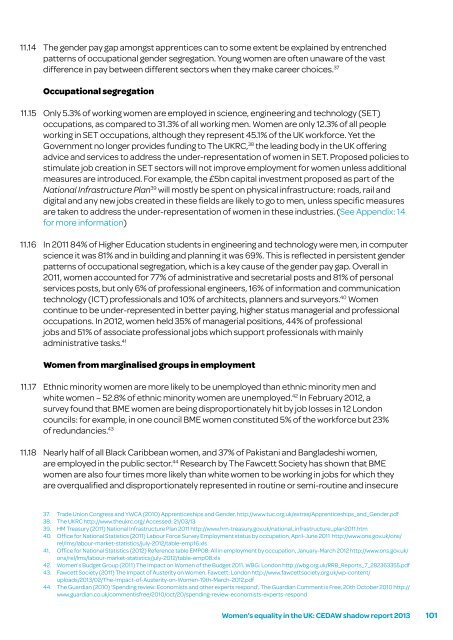Women’s equality in the UK – A health check
Women’s equality in the UK – A health check
Women’s equality in the UK – A health check
You also want an ePaper? Increase the reach of your titles
YUMPU automatically turns print PDFs into web optimized ePapers that Google loves.
11.14<br />
11.15<br />
11.16<br />
11.17<br />
11.18<br />
The gender pay gap amongst apprentices can to some extent be expla<strong>in</strong>ed by entrenched<br />
patterns of occupational gender segregation. Young women are often unaware of <strong>the</strong> vast<br />
difference <strong>in</strong> pay between different sectors when <strong>the</strong>y make career choices. 37<br />
Occupational segregation<br />
Only 5.3% of work<strong>in</strong>g women are employed <strong>in</strong> science, eng<strong>in</strong>eer<strong>in</strong>g and technology (SET)<br />
occupations, as compared to 31.3% of all work<strong>in</strong>g men. Women are only 12.3% of all people<br />
work<strong>in</strong>g <strong>in</strong> SET occupations, although <strong>the</strong>y represent 45.1% of <strong>the</strong> <strong>UK</strong> workforce. Yet <strong>the</strong><br />
Government no longer provides fund<strong>in</strong>g to The <strong>UK</strong>RC, 38 <strong>the</strong> lead<strong>in</strong>g body <strong>in</strong> <strong>the</strong> <strong>UK</strong> offer<strong>in</strong>g<br />
advice and services to address <strong>the</strong> under-representation of women <strong>in</strong> SET. Proposed policies to<br />
stimulate job creation <strong>in</strong> SET sectors will not improve employment for women unless additional<br />
measures are <strong>in</strong>troduced. For example, <strong>the</strong> £5bn capital <strong>in</strong>vestment proposed as part of <strong>the</strong><br />
National Infrastructure Plan 39 will mostly be spent on physical <strong>in</strong>frastructure: roads, rail and<br />
digital and any new jobs created <strong>in</strong> <strong>the</strong>se fields are likely to go to men, unless specific measures<br />
are taken to address <strong>the</strong> under-representation of women <strong>in</strong> <strong>the</strong>se <strong>in</strong>dustries. (See Appendix: 14<br />
for more <strong>in</strong>formation)<br />
In 2011 84% of Higher Education students <strong>in</strong> eng<strong>in</strong>eer<strong>in</strong>g and technology were men, <strong>in</strong> computer<br />
science it was 81% and <strong>in</strong> build<strong>in</strong>g and plann<strong>in</strong>g it was 69%. This is reflected <strong>in</strong> persistent gender<br />
patterns of occupational segregation, which is a key cause of <strong>the</strong> gender pay gap. Overall <strong>in</strong><br />
2011, women accounted for 77% of adm<strong>in</strong>istrative and secretarial posts and 81% of personal<br />
services posts, but only 6% of professional eng<strong>in</strong>eers, 16% of <strong>in</strong>formation and communication<br />
technology (ICT) professionals and 10% of architects, planners and surveyors. 40 Women<br />
cont<strong>in</strong>ue to be under-represented <strong>in</strong> better pay<strong>in</strong>g, higher status managerial and professional<br />
occupations. In 2012, women held 35% of managerial positions, 44% of professional<br />
jobs and 51% of associate professional jobs which support professionals with ma<strong>in</strong>ly<br />
adm<strong>in</strong>istrative tasks. 41<br />
Women from marg<strong>in</strong>alised groups <strong>in</strong> employment<br />
Ethnic m<strong>in</strong>ority women are more likely to be unemployed than ethnic m<strong>in</strong>ority men and<br />
white women <strong>–</strong> 52.8% of ethnic m<strong>in</strong>ority women are unemployed. 42 In February 2012, a<br />
survey found that BME women are be<strong>in</strong>g disproportionately hit by job losses <strong>in</strong> 12 London<br />
councils: for example, <strong>in</strong> one council BME women constituted 5% of <strong>the</strong> workforce but 23%<br />
of redundancies. 43<br />
Nearly half of all Black Caribbean women, and 37% of Pakistani and Bangladeshi women,<br />
are employed <strong>in</strong> <strong>the</strong> public sector. 44 Research by The Fawcett Society has shown that BME<br />
women are also four times more likely than white women to be work<strong>in</strong>g <strong>in</strong> jobs for which <strong>the</strong>y<br />
are overqualified and disproportionately represented <strong>in</strong> rout<strong>in</strong>e or semi-rout<strong>in</strong>e and <strong>in</strong>secure<br />
37. Trade Union Congress and YWCA (2010) Apprenticeships and Gender. http://www.tuc.org.uk/extras/Apprenticeships_and_Gender.pdf<br />
38. The <strong>UK</strong>RC http://www.<strong>the</strong>ukrc.org/ Accessed: 21/03/13<br />
39. HM Treasury (2011) National Infrastructure Plan 2011 http://www.hm-treasury.gov.uk/national_<strong>in</strong>frastructure_plan2011.htm<br />
40. Office for National Statistics (2011) Labour Force Survey Employment status by occupation, April-June 2011 http://www.ons.gov.uk/ons/<br />
rel/lms/labour-market-statistics/july-2012/table-emp16.xls<br />
41. Office for National Statistics (2012) Reference table EMP08: All <strong>in</strong> employment by occupation, January-March 2012 http://www.ons.gov.uk/<br />
ons/rel/lms/labour-market-statistics/july-2012/table-emp08.xls<br />
42. <strong>Women’s</strong> Budget Group (2011) The Impact on Women of <strong>the</strong> Budget 2011. WBG: London http://wbg.org.uk/RRB_Reports_7_282363355.pdf<br />
43. Fawcett Society (2011) The Impact of Austerity on Women. Fawcett: London http://www.fawcettsociety.org.uk/wp-content/<br />
uploads/2013/02/The-Impact-of-Austerity-on-Women-19th-March-2012.pdf<br />
44. The Guardian (2010) ‘Spend<strong>in</strong>g review: Economists and o<strong>the</strong>r experts respond’, The Guardian Comment is Free, 20th October 2010 http://<br />
www.guardian.co.uk/commentisfree/2010/oct/20/spend<strong>in</strong>g-review-economists-experts-respond<br />
<strong>Women’s</strong> <strong>equality</strong> <strong>in</strong> <strong>the</strong> <strong>UK</strong>: CEDAW shadow report 2013 101


